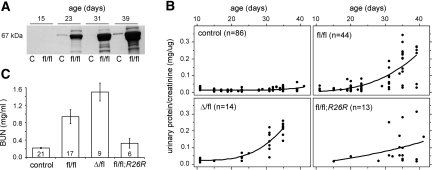Figure 1.
Podocyte-specific Dicer knockout mice develop proteinuria by 3 wk and progress rapidly to end-stage kidney disease. (A) Analysis of urine from controls (C) and Dicerfl/fl;2.5P-Cre mice (fl/fl) by SDS-PAGE reveals progressive albuminuria in mutants by approximately 3 wk. (B) Dicerfl/fl;2.5P-Cre mutants show a corresponding increase in urinary protein/creatinine ratios and progress to end-stage kidney disease by approximately 6 wk. The phenotype was more severe in DicerΔ/fl;2.5P-Cre mutants (Δ/fl) carrying a null allele, and by 5 wk, most showed signs of uremia, including ascites, weight loss, and lethargy uncommon in Dicerfl/fl;2.5P-Cre mice at this age. Conversely, the phenotype was less severe in Dicerfl/fl;2.5P-Cre; R26R mutants (fl/fl; R26R) carrying a Cre-dependent reporter. The data include serial measurements on the number of mice indicated. (C) Blood urea nitrogen values were comparable in Dicerfl/fl;2.5P-Cre;R26R mutants and controls at 5 to 6 wk, whereas the differences between all other genotypes were statistically significant (P < 0.05). Disease progression is correlated with the number of “floxed” genomic loci, likely reflecting the limited efficiency of conditional targeting. Germline and podocyte-specific Dicer heterozygotes (DicerΔ/+ and Dicerfl/+;2.5P-Cre, respectively) had normal urinary protein/creatinine ratios and no overt phenotype.

